In photography, creative inspiration can often come from trying something new and photographing a scene with that technique. Creating glass ball landscapes is one example of this, as it allows you to capture a fish-eye like scene, using a telephoto lens. The glass ball creates a mystique, as many people associate looking into a crystal ball with seeing into the future. However, visions inside a glass ball are easy to achieve with a few simple steps!
How to take landscape photos with a glass ball

In order to get good landscape photos with the glass ball, you’ll need to apply some basic rules, an understanding of the science at work also helps. If you read my previous article on crystal ball photography you will already be familiar with the 7 steps you can follow to take this type of image. Here’s a quick recap:
- Choose a scene that you’d normally shoot with a wide angle lens.
- Photograph this scene with the sun behind you, lighting up the scene you wish to shoot.
- Place the ball somewhere it won’t fall.
- Compose your scene with the glass ball in it.
- Ensure the horizon lines inside the ball and in the background match.
- Focus the camera on the scene inside the ball, which is best achieved using live-view and manual focus.
- Use an aperture of around f/4 as this will keep the ball sharp and the background blurred.
- Take the photograph, and repeat if you’re not happy with the sharpness inside the ball.
- Rotate your image in post-processing so the scene in the ball isn’t upside down. In some cases, you can skip this step.
Alternative glass ball landscapes, and how to compose them
It’s easy to get it in your mind that every scene or situation needs a crystal ball photo. This is not the case and careful consideration needs to be taken when selecting the photograph you’ll take. The most important thing to do is find a compelling subject that shows prominently inside the glass ball. Once you have this basic parameter established below are some differing ways you can compose your glass ball landscape photograph.
1 – The classic composition

Glass ball landscape using the rule of thirds. This classic composition shows the entire ball and was shot at 100mm.
In this type of composition the ball fills the majority of the frame, with the entire edge of the ball visible. This will lead to glass ball landscapes that have an immediate impact and areas to the side of the ball that are blurred out and minimalist in nature. This type of image is most easily taken with a macro or telephoto lens with an aperture of f/4 to create the nice bokeh around the ball.
2- Get in close
Getting closer to the glass ball will emphasize the scene within the ball, this also entails framing that cuts some of the edges of the ball away. A centered composition with both the top and bottom part of the ball can work here, this has the advantage that top and bottom parts of the scene cannot be easily deduced. The other composition follows the rule of thirds, with the edge of the ball showing in the left or right third of the image.
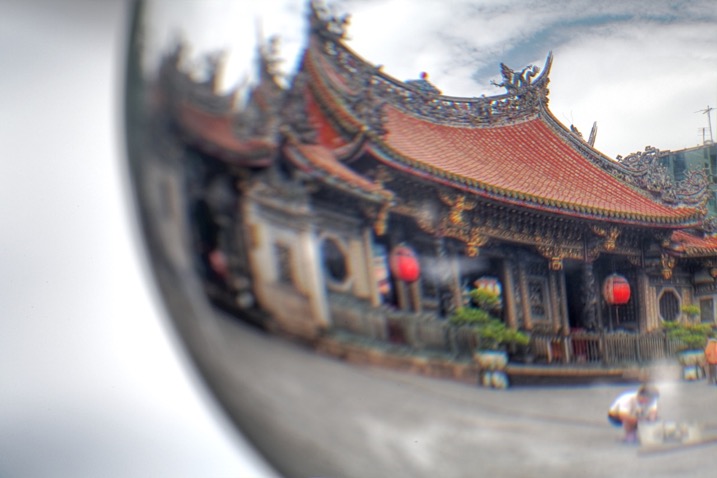
A closer crop focuses the eye more on the image in the ball.
3 – Give the ball a bit of space
There are many ways to photograph the glass ball, and using a wide-angle lens with this technique can be very effective. In this case, you want the background scene to be minimalist, with the ball becoming an accent in the scene. The scene will not likely be rotated during post-processing, so compose to the scene in the background. In this type of the photo, the ball and the landscape scene should form a balanced composition.
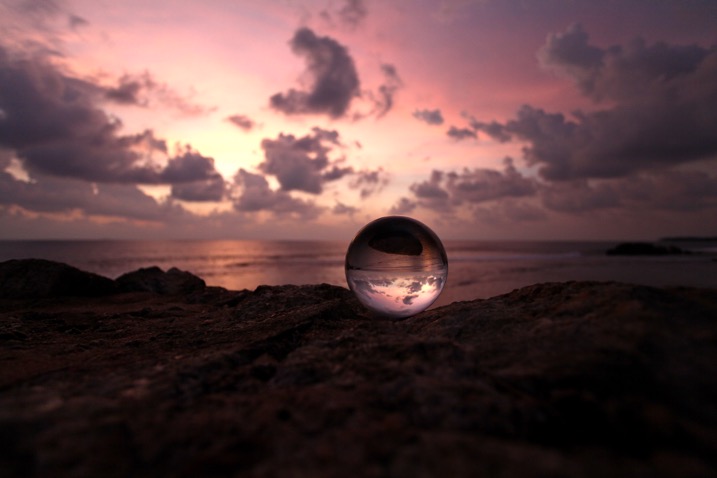
A wider angle of 20mm is used here. The ball is an accent within this frame.
4 – Take it to the high life
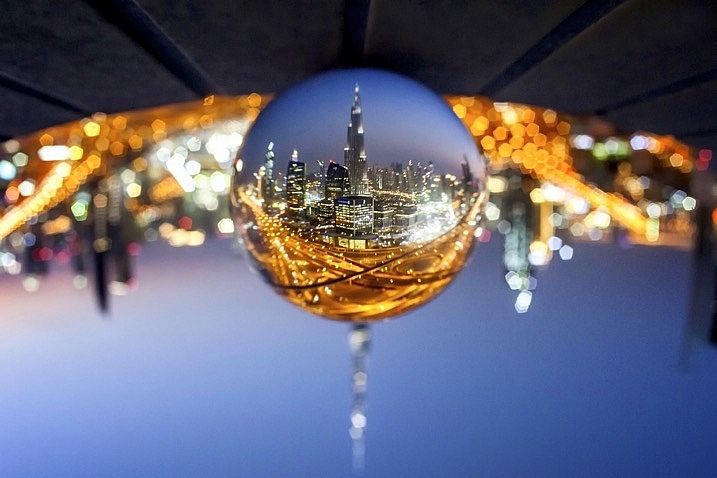
Gaining access to the rooftop provided a great vantage point.
As with all landscape photos, a high vantage point for glass ball images works well. Gaining access to a high building overlooking a city, or climbing a hill are both good options. Once at your high vantage point find a good position to place the ball, so you can see the landscape inside it. You need to ensure the ball will not fall, be very careful with its positioning.
5 – Don’t forget the view from the floor

The view looking up can be just as good as the view looking down.
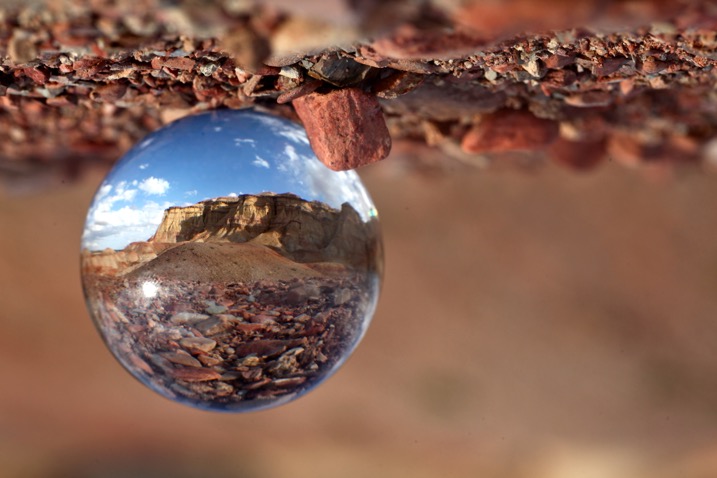
In this photo the ball was placed on the ground, the stones in the foreground add a nice element to this photo.
Placing the ball at street level doesn’t always work, as half the scene will be taken up by the ground. That said there are several situations that really work well with the ball on the ground.
- The ball is ever so slightly higher than the rest of the scene, so it might be at the top of an undulation.
- There is a reflection in the scene from a marble surface or a puddle.
- The ground is an appealing element of the photo because it’s a leaf bed for example.
6 – The human element
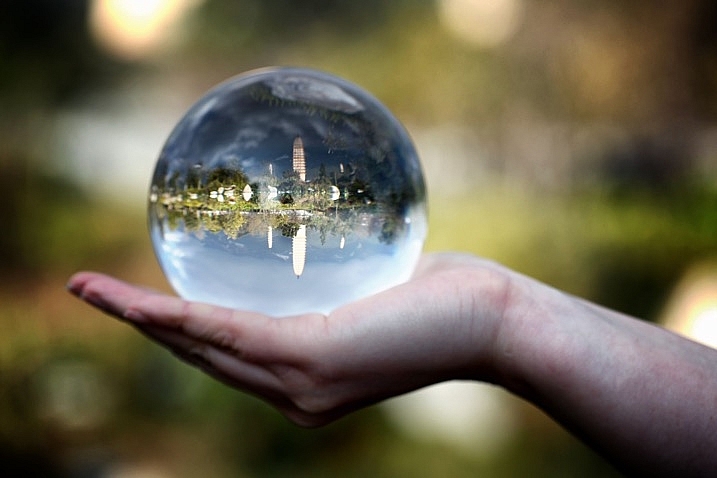
A friend holding the ball in position is an alternative to putting the ball on the ground.
The glass ball landscapes are not always best suited to having people in them. The blurred background may look less appealing with a human shape included in it. There are a couple of ways to humanize your image, though, while still maintaining a minimal feel.
- You eclipse the people inside the ball. Use a long telephoto lens, compression will cause people to appear inside the ball. The background will be clean without the shapes of people in it (as below).
- You take the photo, and someone else is holding the ball. The hand is the human element of this photo, with the landscape still inside the ball (as above).
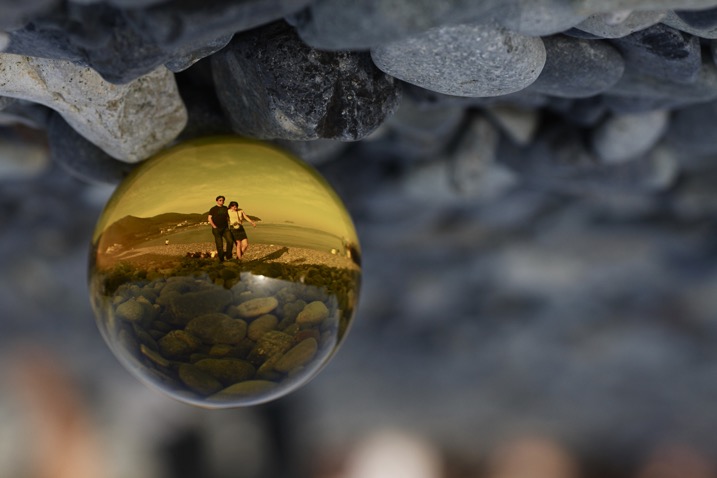
Photographing people inside the ball is tricky, but not impossible.
Where to try this technique
The places you’d visit for regular landscapes will also work for glass ball landscapes. The rooftops of tall buildings in cities work very well or a worm’s eye view from street level can be just as good. The beach or the desert are excellent options due to the minimalist nature of those locations.
Sunset photos at the beach with the glass ball are one of the classics in this genre of photography. Mountains and forests make for good locations as well. A lone tree can be a nice subject, as can lines of tree trunks inside the glass ball. Up in the mountains, you can easily fill the scene inside the ball with a large peak jutting up into the landscape.
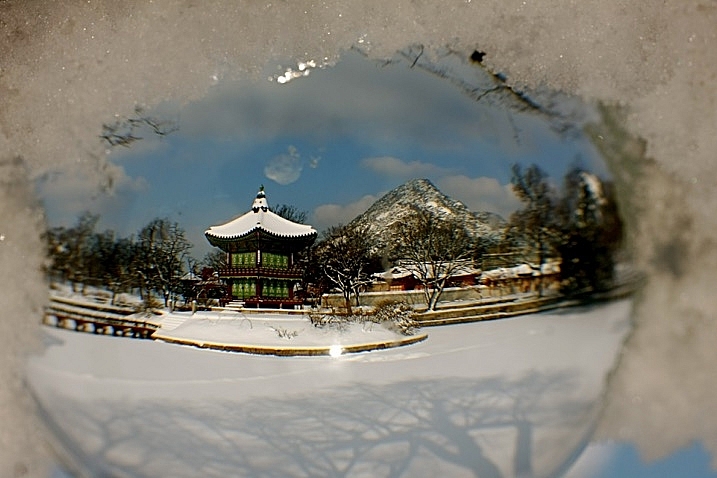
The snow globe is a well-known souvenir gift, which the glass ball can replicate.
Getting out with the glass ball
In my last article on refraction I linked to a site selling an 80mm glass ball, this is a great option though it can be heavy to carry. You can also use a smaller ball for many situations, and when you are carrying a heavy bag of camera gear this is a good idea.
Once you have a glass ball it’s best to dive in and see what works best for you. I’d love to see more examples of your work, it was great to see so many pictures last time. One final tip, be careful in the sunlight with the ball. The glass ball acts as a magnifying glass with the sun’s rays and can burn you, or your property.
The post How to Create Glass Ball Landscapes – 6 Techniques by Simon Bond appeared first on Digital Photography School.
from Digital Photography School http://digital-photography-school.com/create-glass-ball-landscapes/
Buy Lensball Online for Australian FREE Delivery to create your own Glass Ball Photography
ReplyDelete